In sewage, plumbing is crucial in its management as it ensures the correct collection, transport and disposal of contaminated water together with the waste from a building to its final destination. A well-designed and maintained plumbing system prevents blockages, leaks and sewage backups that can cause structural damage and health hazards. It also ensures that sewage is efficiently routed to treatment plants, where it is processed to remove contaminants before being released into the environment.
Properly functioning plumbing in sewage systems is also essential for the prevention of odors and the proliferation of bacteria and pests. A professional plumber must be trained to install and maintain pipes, grease traps, septic tanks and other critical components, ensuring that the entire system complies with local codes and regulations. This not only protects public health, but also contributes to water conservation and environmental sustainability.
Sewage History
Throughout history, sewage management has evolved significantly, reflecting advances in engineering and public health understanding. In ancient civilizations such as Mesopotamia and the Roman Empire, the first sewage systems were constructed. The Romans, for example, developed a network of sewers, with the Cloaca Maxima being one of the world’s first and largest drainage systems. These structures were essential to divert sewage from urban areas and reduce the proliferation of disease.

Cloaca Maxima in Rome
During the Middle Ages, sewage management declined, especially in Europe, where the lack of adequate infrastructure contributed to the spread of epidemics. It was not until the 19th century, with the Industrial Revolution, that cities began to invest in modern sewage systems. In London, engineer Joseph Bazalgette designed a sewage system that revolutionized the way sewage was managed, drastically reducing waterborne diseases such as cholera. At this time, cast iron pipes began to be used, which offered greater strength and durability compared to the materials used previously.
In the 20th century, the implementation of sewage treatment plants marked another significant advance. These systems not only collect and transport wastewater, but also treat it to remove contaminants before returning it to the environment. This period also saw the introduction of copper pipes in plumbing installations, due to their resistance to corrosion and ability to withstand high pressures, thus improving the sanitation infrastructure.
Today, modern plumbing includes advanced technologies such as digital monitoring systems and biological treatment methods that improve the efficiency and sustainability of sewage management. Continued evolution in plumbing and sewage management is critical to meeting the environmental and public health challenges of the 21st century. Innovation in materials, such as PVC and PEX piping, and the development of trenchless repair techniques are changing the landscape, making systems more durable and less invasive for cities. The history of sewage plumbing is a testament to human creativity and its ability to solve complex problems in a sustainable manner.
What does sewage management look like?
Sewage management is a vitally important task in protecting public health and the environment. Its proper management prevents contamination of water sources, preserves ecosystems and ensures a continuous supply of clean water for various human activities. Without proper management, sewage can become a source of disease and negatively affect the quality of life of communities.
However, sewage management is not without its challenges. Among the most significant are rapid urbanization and population growth, which increase the demand on existing systems. In addition, aging infrastructure and the lack of adequate funding for upgrading represent considerable obstacles. Another crucial challenge is the variability in the composition of sewage, which can range from domestic to industrial waste, each with different treatment and management needs.
Sewage can be mainly classified into three categories according to its origin: domestic, industrial and urban. Domestic sewage comes from everyday household activities and contains organic wastes and everyday chemicals. Industrial sewage, on the other hand, includes specific pollutants from manufacturing and production processes. Finally, urban sewage is a combination of domestic, industrial and storm water, which complicates its management due to the variety of pollutants present.

The systems that manage sewage are mainly divided into two fundamental parts: the collection system and the disposal system. In addition, the sewage management process comprises several stages that ensure its collection, transport and final disposal.
For the process to be successful, sewage systems are composed of several parts that work together to ensure the efficient management of sewage. Collection pipes collect water from homes, industries and urban areas. Lift stations are essential in areas with challenging topography, as they maintain the continuous flow of water through submersible pumps and sewage pumps. These sewage pumping systems are critical to overcome slopes and long distances. Finally, the main sewers are the last part of the system; they carry large volumes of sewage to its final destination, ensuring its proper handling.
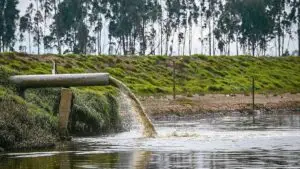
As for the final destination of the sewage, there are two main options: discharge into natural water bodies, such as rivers, or transport to treatment plants. When the first option is chosen, it is essential that the water meets quality standards to avoid contamination of aquatic ecosystems, although unfortunately this is not always the case. Treatment plants, on the other hand, are equipped to handle and process the sewage, ensuring that pollutants are reduced before disposal or reuse. In addition, septic systems can be used for decentralized sewage treatment in rural or sparsely populated areas, and for graywater management, which can be reused in certain contexts.
With this in mind, let us not forget that proper management of sewage is crucial for public health and environmental preservation and that despite the challenges, adequate infrastructure and efficient management make it possible to manage this water in a sustainable manner, ensuring that it does not become a source of pollution and contributing to the responsible use of water resources. Adequate drainage and the implementation of advanced technologies are key elements for success in this area.
Professions required for the sewerage sector
To create, repair and maintain sewage systems, there are professions that are essential. The civil engineer is fundamental in the planning and design of infrastructures for the collection and treatment of sewage. They ensure that structures such as sewage systems and treatment plants are designed and constructed efficiently and in compliance with regulations, applying their knowledge of hydraulics, fluid dynamics, environmental regulations and project management.
The environmental engineer is responsible for the development and optimization of sewage treatment processes. They ensure that treatment systems are efficient and comply with environmental regulations, using their knowledge of chemistry, environmental microbiology and pollution assessment. Their work is crucial to protecting public health and the environment.
The sewage treatment plant technician is responsible for the daily operation and maintenance of treatment equipment. This professional adjusts processes to ensure treatment efficiency, manages the biosolids generated, and performs preventive and corrective maintenance of equipment, ensuring optimal plant operation. It is essential that these technicians wear personal protective equipment, including safety gloves, safety goggles, safety boots and respirators, to ensure their safety while performing potentially hazardous tasks.
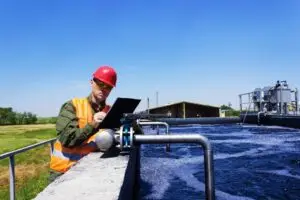
The plumber is crucial to the installation and repair of plumbing and drainage systems. This professional detects and repairs leaks, installs sewer systems and ensures compliance with plumbing codes. With knowledge of proper materials and joining techniques, the plumber ensures the integrity and functionality of drainage systems. In addition, the plumber uses various plumbing tools and venting equipment to maintain safety and efficiency in their work.
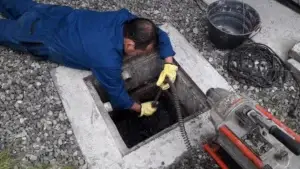
The sewage diver performs underwater inspections and repairs on structures such as settling tanks and pump stations. Knowledgeable in commercial diving techniques, safety standards and equipment handling, this professional is essential to maintain underwater infrastructures in good condition and ensure their optimal functioning. The use of personal protective equipment is also crucial for these professionals, given the potentially hazardous environment in which they operate.
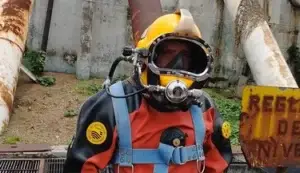
The chemical engineer specializes in developing and optimizing chemical processes for sewage treatment. With expertise in chemical processes, treatment design and environmental regulations, this engineer works to remove specific contaminants and improve the efficiency of chemical treatments in plants.
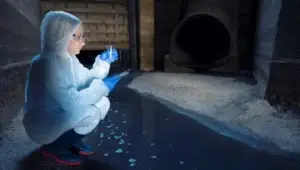
Each of these professions brings specific knowledge and skills that are vital to the efficient and safe operation of sewage systems. Collaboration among these professionals ensures that all aspects of sewage management, from collection and treatment to disposal and communication with the community, are performed effectively and sustainably. Pipeline inspectors, equipped with advanced tools, play a crucial role in detecting and repairing damage to the pipeline system, ensuring that it is maintained in optimal condition to prevent system failure.
Repair and maintenance of sewage systems
The repair and maintenance of sewage systems is a fundamental aspect to ensure their efficient operation and prevent environmental pollution problems. Detecting problems in these systems is the first crucial step in proper maintenance. Signs of problems can include foul odors, areas of stagnant water, sewage discharges in inappropriate locations, and visible blockages in pipes. In addition, constant monitoring of flow rates and pressures in the system can reveal irregularities that indicate leaks or blockages.
Inspection methods for identifying problems in sewage systems have evolved significantly due to technology. One commonly used technique is video camera inspection, where a high-resolution inspection camera is inserted into pipes to provide a detailed view of the interior. This method allows cracks, intrusive roots, sediment accumulations and other types of damage to be accurately identified. In addition, the use of acoustic leak detection equipment makes it possible to locate leaks in hard-to-reach locations by identifying characteristic sounds produced by leaks.
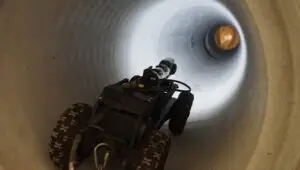
Parts of the sewage system that are typically damaged include pipes, seals and pumps. Pipes can suffer cracks or breaks due to corrosion, soil movement or tree root intrusion. Joints, which connect pipe runs, are also vulnerable to leaks and misalignment. Pumps, essential for maintaining sewage flow in areas of challenging topography, can fail due to mechanical wear or electrical problems. Identifying and repairing these components in a timely manner is crucial to avoid service interruptions.
In addition, inspection boxes are essential to facilitate access to critical points in the system, allowing visual assessment and efficient maintenance of pipes and connections. On the other hand, check valves play a crucial role in preventing backflow of sewage into the system, ensuring continuous and safe operation of the sewage system.
Special equipment and tools for sewage system repair are varied and specific to the type of damage. For pipe repairs, repair robots are used that can seal cracks and joints from inside the pipe without extensive excavation. Cutting and root removal tools are essential for removing obstructions caused by vegetation.
In addition, pipe wrenches, adjusting wrenches and pipe wrenches are indispensable for maintaining and tightening connections. Pipe welding and pipe glue are common techniques for repairing and joining damaged pipes. Sealing tapes and rubber gaskets are used to ensure watertight connections and prevent leaks. Inspection cameras and sensors for level, temperature, flow, humidity, pressure and pH allow monitoring the system and detecting problems before they become major failures.
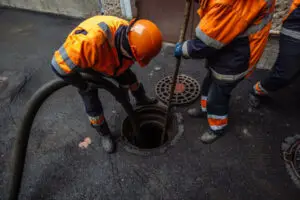
Preventive maintenance practices are essential to prolong the life of sewage systems and reduce the need for costly repairs. These practices include regular cleaning of pipes to prevent sediment buildup and periodic inspection with video cameras to identify problems before they become major failures. Regular maintenance of pumping stations, including checking and replacing worn parts, is also critical to ensure efficient operation.
Preventing damage to sewage systems involves a combination of good installation, maintenance and ongoing monitoring practices. Proper installation of piping with high quality materials and robust joining techniques can significantly reduce the incidence of problems.
In addition, the implementation of real-time monitoring systems allows for early detection of irregularities, facilitating rapid intervention before problems escalate. Community education and awareness of the proper use of the sewage system also play an important role in preventing damage by avoiding the discharge of inappropriate materials that can cause blockages or damage to pipes.
New and current technologies used in this sector
The application of new technologies in sewage treatment is of utmost importance in this sector. These innovations are divided between devices that improve the management of sewage in the sewage system or disinfection devices such as UV Styling Devices or Ozonizers. In addition, the use of remote monitoring systems ensures the continuous and efficient operation of these devices, allowing quick and accurate interventions when necessary.
In addition to these disinfection devices are separation devices such as settling tanks, clarifiers, sand filters, gravel filters, filter beds, ion exchangers, reverse osmosis membranes and ultrafiltration membranes, as well as other devices used at different stages of treatment. Advanced control and automation systems are also used in treatment plants, integrating on-line sensors and real-time data analysis to optimize operational performance and reduce costs.
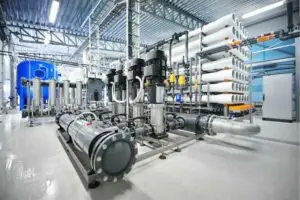
Reverse osmosis system
In addition, cathodic protection, protective coatings and anti-corrosion paints are essential to prevent corrosion and maintain the integrity of machinery, piping and metal structures that are in constant contact with sewage. While joint sealants as well as epoxy coatings are of great importance either by providing a watertight system or by helping with their high resistance to aggressive chemicals present in the sewage.
It also highlights the use of software tools such as AutoCAD, IBM Maximo, SCADA or EPANET, which is used for hydraulic modeling, simulating water distribution networks to improve their design and efficiency.Joint sealants play a fundamental role in the construction and maintenance of infrastructures, preventing leaks and ensuring a watertight system.
Modern technologies have revolutionized sewer systems, facilitating more efficient and sustainable management.Devices such as electromagnetic flow sensors and ultrasonic level sensors are used to monitor in real time the flow and quality of sewage.In addition, pressure sensors can detect variations that may indicate blockages or leaks in the system.Water quality meters, equipped with optical or electrochemical technologies, provide accurate data on contaminant levels
In addition, robots equipped with thermal and infrared cameras facilitate pipeline inspection, accurately detecting damage and reducing the need for manual inspections.Cloud-based data management systems, such as Geographic Information Systems (GIS), enable analysis and informed decision making, improving the planning and maintenance of sewer infrastructure.
Finally, it is worth mentioning that the use of biogas generated in treatment plants as an energy source is significant, contributing to the sustainability and energy efficiency of the sewage treatment process.
Highly relevant sewage standards
Sewage standards vary according to the environmental regulations of each country or region, but always focus on key parameters to ensure environmental safety and public health. In the United States and Canada, for example, these standards are fundamental to system efficiency and sustainability. They establish precise guidelines from design to maintenance of sewage-related infrastructure.
In the United States, the EPA (Environmental Protection Agency) is the primary authority responsible for setting and enforcing environmental standards, including those related to sewage. In addition, OSHA (Occupational Safety and Health Administration) regulates occupational safety and health issues related to the operation and maintenance of sewage treatment systems. The IPC (International Plumbing Code) and the UPC (Uniform Plumbing Code) provide detailed guidelines on the design and installation of plumbing systems, which are essential for sewage infrastructure.
In Canada, standards are also rigorous. The CPC (Canadian Plumbing Code) regulates plumbing nationwide, ensuring that sewage systems are safe and efficient. The CSA (Canadian Standards Association) develops national standards covering everything from the design to the operation of sewage treatment systems.
These standards for the proper management of sewage are crucial to ensure effective and responsible operations in the collection, transport and disposal of wastewater. In each country, the standards specify how sewage systems and associated infrastructure should be designed and maintained, including technical criteria such as conveyance capacities, network sizing, and the use of materials that ensure long-term durability and functionality.
ASTM (American Society for Testing and Materials) and ASME (American Society of Mechanical Engineers) provide technical standards on materials and test methods that are essential for the construction and maintenance of sewage infrastructure.
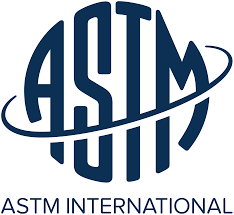

In addition, the standards regulate operational and maintenance aspects, establishing procedures for regular inspection, cleaning of networks, calibration of monitoring equipment and repair of deteriorated infrastructures. These measures are essential to prevent failures and ensure that systems operate efficiently and safely, minimizing risks to public health and the environment. For example, the NEC (National Electrical Code) and NFPA 70E (NFPA Electrical Safety Standard) establish electrical safety standards that are crucial to the safe operation of sewage treatment facilities. Also, NFPA 101 (NFPA Life Safety Code) provides guidelines on safety and life safety in these infrastructures.
Finally, it is important to emphasize that technical standards must be reviewed and approved by the American National Standards Institute (ANSI), the national standards authority, before being adopted nationwide. ANSI approval is crucial to ensure that the standards align with national requirements and needs in the sewage sector.
Rigorous compliance with these standards not only promotes sustainable sewage management practices, but also contributes to improving the quality of life in communities by ensuring proper sewage management. Following these standards strengthens the country’s water infrastructure and promotes a healthier and safer environment for all.
Challenges in sewage treatment with certain chemicals.
The use of household chemicals is a common practice in everyday life, but their impact on sewage and thus on treatment systems should not be underestimated. Products such as detergents, disinfectants, cleaning products, medicines and cosmetics may contain substances that negatively affect biological treatment processes and the quality of treated water.
Detergents, for example, often contain phosphates that can cause eutrophication in receiving water bodies. Eutrophication is the process of excessive nutrient enrichment, which leads to excessive growth of algae and aquatic plants. This overgrowth can deplete dissolved oxygen in the water, affecting aquatic life and causing the death of fish and other organisms. To mitigate this problem, many countries have implemented regulations to reduce or eliminate the use of phosphates in household detergents.
Antibacterial products, such as soaps and disinfectants containing triclosan and triclocarban, can also have a significant impact on sewage treatment systems. These compounds are resistant to biodegradation and can inhibit microbial activity in biological treatment processes, reducing system efficiency. In addition, antibacterial chemicals can contribute to the development of antibiotic-resistant bacteria, posing a threat to public health.
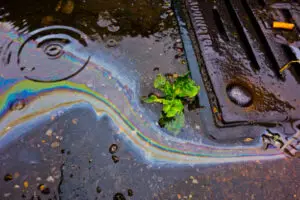
Petrol Oil In Water Running Down the Drain
Drugs and pharmaceuticals, when discharged into sewage systems, can cause significant problems. Many of these compounds are not completely removed in conventional treatment processes and can reach receiving water bodies, where they can affect aquatic fauna. For example, synthetic estrogens present in some medications can cause feminization of fish and affect their populations.
Cleaning products and cosmetics also contain a variety of chemical compounds that can affect sewage treatment systems. Surfactants, solvents, and fragrances can interfere with biological and chemical processes used in water treatment. Some of these compounds can be toxic to the microorganisms used in biological treatment processes.
To mitigate these effects, sewage treatment systems implement various technologies, such as sewage filters, which include sand filters, activated carbon filters and membrane filters. Sand filters are effective in removing suspended particles and organic matter, while activated carbon filters are especially useful for adsorbing organic compounds and chemicals present in household products. Membrane filters, on the other hand, allow the physical separation of contaminants at the molecular level, significantly improving the quality of treated water.
Grease traps and oil traps are essential to prevent these contaminants from entering the sewage treatment system. These traps separate and retain fats, oils and grease before they reach the treatment plants, preventing them from interfering with the biological and mechanical treatment processes. Sedimentation traps also play an important role in removing solid particles and sediment from sewage, ensuring that treatment systems operate efficiently.
To minimize the impact of household chemicals in sewage, it is crucial to promote responsible practices among consumers. This includes the use of environmentally friendly cleaning products and detergents, which contain fewer toxic substances and are more readily biodegradable. It is also important to educate consumers about the proper disposal of medicines and pharmaceuticals, avoiding their discharge into the sewage system.
Education and Awareness of the issue
Education and awareness of sewage are crucial to its sustainable management. Understanding the treatment processes and the risks associated with improper management is essential to encourage responsible practices. Sewage contains organic matter, chemicals, heavy metals and pathogens that can cause disease and environmental contamination.
For professionals in the industry, continuing education through courses and certifications is vital to stay current with new technologies and best practices. Professional associations and educational institutions should offer training programs that cover everything from the basics to advanced technologies and current regulations.
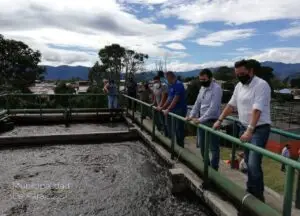
The general public must also be educated on the importance of proper sewage management. Awareness campaigns can include community workshops, brochures, social media campaigns, and educational programs in schools. Integrating these topics into the school curriculum through hands-on activities and visits to treatment plants fosters early understanding.
Communities and businesses play a key role in promoting responsible practices. Community leaders can organize educational events, while businesses can adopt environmentally responsible policies and participate in certification programs.
Collaboration between the public and private sectors is vital, as is the use of modern communication technologies to extend the reach of awareness campaigns. Mobile apps and online platforms can provide interactive resources and educational videos, fostering greater understanding and responsibility in sewage management, thus protecting water resources and public health.
Conclusion
Effective sewage management is critical to environmental health and preservation. Throughout this article, we have explored several key aspects that influence sewage management in different contexts. From the importance of adequate infrastructure and maintenance of sewerage systems to the implementation of advanced treatment technologies and the promotion of treated water reuse, each theme highlights the complexity and interconnectedness of the systems involved.
Sewage education and awareness emerge as key pillars to ensure responsible practices among citizens, professionals, and businesses. Integrating these topics into educational curricula, along with community campaigns and the use of modern communication technologies, promotes a deeper understanding of the challenges and solutions in sewage management.
Ultimately, collaboration between the public and private sectors is essential to develop effective policies and ensure the implementation of sustainable practices. By working together, we can mitigate the negative impacts of sewage, ensuring the protection of our water resources and the health of communities.